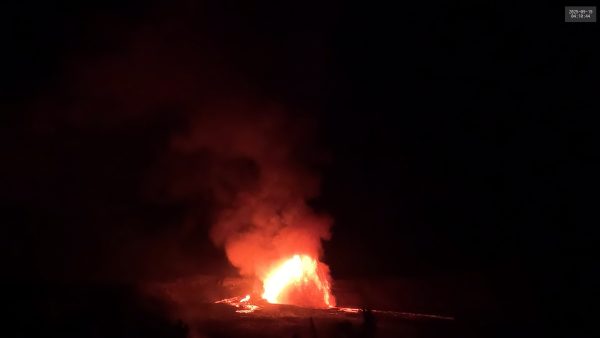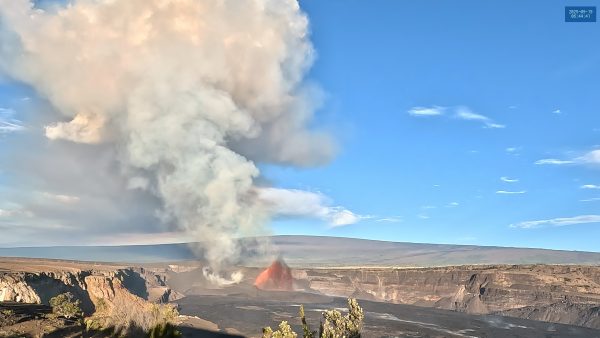Since the last visit in December, what can be seen of the volcano has changes, as the level inside the crater has come up considerably, and the vents are now at the top of a large cinder cone. Spent a couple of days checking out the various viewpoints to determine which one best suited our needs. The viewpoint off the old Crater Rim Road before from the Keanakako'i Crater still seemed the best, although just down the road across from the crater seemed possible.
Across from the Kilauea Military Camp along the rim, between the trees, were a number of viewpoints with direct views at the vents, but these would view an inclined eruption column head on. It was from one of these at around 0838 on the morning of 17 September that we saw the first lava overflow for the upcoming eruption episode. Saw two from there, indicating that it was time to start paying attention.
We arrived around midnight to start 18 September. We decided to try the farther overlook, to stay away from the crowds at the main overlook. We had the area to ourselves, and started watching the overflows. The overflows were quite consistent, lasting about two minutes and occurring every seven to nine minutes. This location was a bit breezy, and during much of the night until dawn it was damp from a consistent mist that never really turned into rain.
Around noon the overflows stopped. We returned to the car and the parking lot to get out of the wind for a while. A couple of overflows around 1400 got us back out, but these overflows again stopped, with nothing going on until sunset. We decided to go back to the car to get a nap and wait for something to happen. By 2100, nothing had, se that was when we decided that we needed to return to our cabin to rest up, have something to eat, and recharge our various powered devices. Put the V1 webcam view on the wall screen and waited.
Around midnight (again) we saw the first lava overflow since sunset, and knew it was time to head out. The parking lot was half empty, which was a pleasant surprise. We had thought that there would be a considerable number of people waiting. Decided that were we had waited the day before was too windy and exposed, and would need to join the rest of the crowd. We left our cabin at 0100, arrived at the parking lot 15 minutes later, and walked out to the main overlook, arriving around 00:45. The overflow had continued, or restarted before we arrived. (The glow was consistent on the walk out.) We found the rope line pretty much filled with people waiting. Found a spot that gave us an unobstructed view, and started another wait.
This time the overflows were more irregular and longer. A couple of hours later we got the strongest one yet, and it looked as if it was finally going to go into a full eruption. The USGS start time was 0311, but from our point of view it had started well before that.
Unlike a geyser, where the maximum height is near the start. This eruption took its time, at least a half hour, to slowly reach full height. For this eruption, that height seemed around 225m/750ft, and it stayed there for several hours.
Several times during this period, starting at 0400, the South Vent started to overflow, then well up strongly for a minute or two. It looked like it too was about to start erupting, but it never did. By dawn this activity had subsided.
Before dawn there was an influx of people who seemed to only be there to take selfies, no matter what the volcano was doing, so they got lucky to see an eruption. By sunrise most of the people waiting overnight had left.
Just before noon the South Vent overflowed again, the first time in daylight. With the second overflow, it seemed apparent that the eruption was ending. Over a matter of a couple of minutes the North Vent eruption height dropped, and then it quit.
People applauding the end of an eruption is not just a Yellowstone Grand Geyser phenomena. That happened with the end of this eruption.
There seemed to be a large contingent of people arriving just after the eruption ended. Overheard a few mentioning that they were staying at resorts in the Kona area, which is well over two hours drive away. So I would suspect these are people who hadn't intended to be hear, but in the morning heard of the eruption and headed over, leaving at the start of Tourist Hours (1000-1700), arriving just in time to miss everything.


